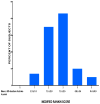Potential role of tele-rehabilitation to address barriers to implementation of physical therapy among West African stroke survivors: A cross-sectional survey
- PMID: 28991682
- PMCID: PMC5679737
- DOI: 10.1016/j.jns.2017.08.3265
Potential role of tele-rehabilitation to address barriers to implementation of physical therapy among West African stroke survivors: A cross-sectional survey
Abstract
Background: The greatest burden from stroke-related disability is borne by Low-and-Middle Income countries (LMICs) where access to rehabilitation after stroke is severely challenged. Tele-rehabilitation could be a viable avenue to address unmet rehabilitation needs in LMICs.
Objectives: To assess the burden of post-stroke physical deficits, rates of utilization of physiotherapy services, and perceptions of tele-rehabilitation among recent Ghanaian stroke survivors.
Methods: Using a consecutive sampling strategy, 100 stroke survivors attending an outpatient Neurology clinic in a Ghanaian tertiary medical center were enrolled into this cross-sectional study. After collecting basic demographic data, clinical history on stroke type, severity and level of disability, we administered the validated 20-item Functional Independence Measure questionnaire to evaluate functional status of study participants and an 8-item questionnaire to assess participants' attitudes towards telemedicine administered rehabilitation intervention.
Results: Mean±SD age of study participants was 57.2±13.3years of which 51.0% were males with a mean duration of stroke of 1.3±2.2years. 53% had Modified Rankin scores of ≥3, 57% were fully independent and only 27% reported utilizing any physiotherapy services. Barriers to access to physiotherapy included financial constraints due to cost of physiotherapy services and transportation as well as premature discharge from physiotherapy to avoid overburdening of available physiotherapy services. These factors led to the limited provision of rehabilitative therapy. Participants held positive views of the potential for tele-rehabilitation interventions (80-93%). However, while 85% owned mobile phones, only 35% had smart phones.
Conclusion: Despite, a high burden of residual disability, only about 1 out of 4 stroke patients in this Ghanaian cohort was exposed to post-stroke physiotherapy services, largely due to relatively high costs and limited health system resources. These Ghanaian stroke patients viewed the potential role of Tele-rehabilitation as positive, but this promising intervention needs to be formally tested for feasibility, efficacy and cost-effectiveness.
Keywords: Barriers and facilitators; Functional independence; Physical therapy; Stroke survivors; Tele-rehabilitation.
Copyright © 2017 Elsevier B.V. All rights reserved.
Conflict of interest statement
Figures

Comment in
-
Comments on potential role of tele-rehabilitation to address barriers to implementation of physical therapy among West African stroke survivors: A cross-sectional survey.J Neurol Sci. 2017 Nov 15;382:161. doi: 10.1016/j.jns.2017.09.037. Epub 2017 Sep 27. J Neurol Sci. 2017. PMID: 28965998 No abstract available.
-
Response by Sarfo and Ovbiagele to letter regarding "potential role of tele-rehabilitation to address barriers to implementation of physical therapy among West African stroke survivors: A cross-sectional survey".J Neurol Sci. 2017 Nov 15;382:162-163. doi: 10.1016/j.jns.2017.09.038. Epub 2017 Sep 28. J Neurol Sci. 2017. PMID: 28992944 No abstract available.
Similar articles
-
Pilot trial of a tele-rehab intervention to improve outcomes after stroke in Ghana: A feasibility and user satisfaction study.J Neurol Sci. 2018 Apr 15;387:94-97. doi: 10.1016/j.jns.2018.01.039. Epub 2018 Feb 1. J Neurol Sci. 2018. PMID: 29571880 Free PMC article.
-
Comments on potential role of tele-rehabilitation to address barriers to implementation of physical therapy among West African stroke survivors: A cross-sectional survey.J Neurol Sci. 2017 Nov 15;382:161. doi: 10.1016/j.jns.2017.09.037. Epub 2017 Sep 27. J Neurol Sci. 2017. PMID: 28965998 No abstract available.
-
Satisfaction of Nigerian stroke survivors with outpatient physiotherapy care.Physiother Theory Pract. 2017 Jan;33(1):41-51. doi: 10.1080/09593985.2016.1247931. Epub 2016 Nov 28. Physiother Theory Pract. 2017. PMID: 27892812
-
Combining the benefits of tele-rehabilitation and virtual reality-based balance training: a systematic review on feasibility and effectiveness.Disabil Rehabil Assist Technol. 2019 Jan;14(1):2-11. doi: 10.1080/17483107.2018.1503738. Epub 2018 Oct 14. Disabil Rehabil Assist Technol. 2019. PMID: 30318952
-
Effect of Increased Intensity of Physiotherapy on Patient Outcomes After Stroke: An Economic Literature Review and Cost-Effectiveness Analysis.Ont Health Technol Assess Ser. 2015 Mar 1;15(7):1-43. eCollection 2015. Ont Health Technol Assess Ser. 2015. PMID: 26366241 Free PMC article. Review.
Cited by
-
Prevalence, Trajectory, and Predictors of Poststroke Fatigue among Ghanaians.J Stroke Cerebrovasc Dis. 2019 May;28(5):1353-1361. doi: 10.1016/j.jstrokecerebrovasdis.2019.02.002. Epub 2019 Feb 21. J Stroke Cerebrovasc Dis. 2019. PMID: 30797644 Free PMC article.
-
Pilot trial of a tele-rehab intervention to improve outcomes after stroke in Ghana: A feasibility and user satisfaction study.J Neurol Sci. 2018 Apr 15;387:94-97. doi: 10.1016/j.jns.2018.01.039. Epub 2018 Feb 1. J Neurol Sci. 2018. PMID: 29571880 Free PMC article.
-
Improving the quality of care for people who had a stroke in a low-/middle-income country: A qualitative analysis of health-care professionals' perspectives.Health Expect. 2020 Apr;23(2):450-460. doi: 10.1111/hex.13027. Epub 2020 Jan 22. Health Expect. 2020. PMID: 31967387 Free PMC article.
-
Long-Term Outcomes of Stroke in a Ghanaian Outpatient Clinic.J Stroke Cerebrovasc Dis. 2018 Apr;27(4):1090-1099. doi: 10.1016/j.jstrokecerebrovasdis.2017.11.017. Epub 2017 Dec 20. J Stroke Cerebrovasc Dis. 2018. PMID: 29275059 Free PMC article.
-
Post-intervention qualitative assessment of mobile health technology to manage hypertension among Ghanaian stroke survivors.J Neurol Sci. 2019 Nov 15;406:116462. doi: 10.1016/j.jns.2019.116462. Epub 2019 Sep 13. J Neurol Sci. 2019. PMID: 31610382 Free PMC article.
References
-
- Connor MD, Walker R, Modi G, et al. Burden of stroke in black populations in sub-Saharan Africa. Lancet Neurol. 2007;6:269–78. - PubMed
-
- Feigin VL, Roth GA, Naghavi M, et al. Global burden of stroke and risk factors in 188 countries, during 1990–2013: a systematic analysis for the Global Burden of Disease Study 2013. Lancet Neurol. 2016;15(9):913–924. - PubMed
-
- O’Donnell MJ, Chin SL, Rangarajan S, et al. Global and regional effects of potentially modifiable risk factors associated with acute stroke in 32 countries (INTERSTROKE): a case-control study. Lancet. 2016;388(10046):761–75. - PubMed
-
- Sarfo FS, Akassi J, Awuah D, et al. Trends in Stroke admission & mortality rates from 1983 to 2013 in Central Ghana. J Neurol Sci. 2015 Oct 15;357(1–2):240–5. - PubMed
MeSH terms
Grants and funding
LinkOut - more resources
Full Text Sources
Other Literature Sources
Medical

